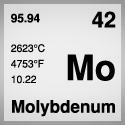
RECOGNIZED FOR EXCELLENT STRENGTH AT HIGH TEMPERATURES, ITS HIGH MELTING POINT OF 2610°C (4730°F), AND ITS HIGH RESISTANCE TO CORROSION.
.
Molybdenum has the ability to withstand many acids including sulfuric, hydrochloric, hydrofluoric, and most organic acids, as well as many molten materials, such as metals, alloys glasses, compounds, etc. Molybdenum is corroded by alkalis in the presence of oxidants.
Molybdenums high melting point makes excellent for use as vapor deposition boats and dishes. Vessels of molybdenum have also been used for such applications as processing nuclear fuel pellets at temperatures up to 1650°C (3000°F). In addition, molybdenum crucibles are durable and will withstand repeated rough handling.
PROPERTIES
Molybdenum is a silvery white metal. It is softer and more ductile than tungsten, its sister element.
- Atomic No. 42
- Atomic Wt. 95.94
- Specific gravity 10.34
- Melting Point 2617°C
- Coefficient of Thermal Expansion 4.8 X 10-6/°K
- Specific Heat 0.060 cal/g/°K
- Ultimate Tensile Strength (Room Temperature, Annealed) 95–115 ksi
- Yield Tensile Strength (Room Temperature, Annealed) 80–95 ksi
- Poisons Ratio 0.30
- Modulus of Elasticity 4.63 X 107 psi
- Recrystallization Temperature 900°C to 1300°
Molybdenum EDM, molybdenum crucibles, molybdenum tubes or molybdenum tubing are all available from MTI Albany.
GENERAL CORROSION RESISTANCE
Molybdenum has the ability to withstand many non-oxidizing mineral and organic acids. It will corrode in alkalis in the presence of oxidizing materials. The metal is not affected by many molten metals and glasses. It is resistant to molten lead, gallium, lithium, sodium, potassium and bismuth. Molybdenum begins to oxidize in air at a temperature of 400°C.
This data is based on laboratory testing only. Your in-plant results may differ. Testing is recommended under other conditions as needed.
LABORATORY APPLICATIONS
In air or oxygen-containing atmospheres, molybdenum is not oxidized to any considerable degree at temperatures below 400°C (750°F). At 400°C (750°F) and up molybdic oxide is formed and begins to sublime.
It is recommended that for high temperature applications, except for brief periods, fusions should be performed in a vacuum or inert atmosphere. The crucibles could then be heated up to about 2100°C (3800°F).
CORROSION RESISTANCE OF MOLYBDENUM
Molybdenum's resistance to corrosion by many materials is exemplified in the following Corrosion Resistance Table.
|
SUBSTANCE |
|
REACTION |
|
Air or Oxygen |
|
Beginning oxidation at 400°C (750°F) Strong oxidation above 600°C (1110°F) Sublimation of MoO2 above 700°C (1300°F) |
|
Ammonia |
|
Slight, but complete corrosion |
|
Aqueous Ammonia |
|
No Reaction |
|
Aqua Regia |
|
Cold, dilute or concentrated; no reaction |
|
Argon |
|
No reaction |
|
Boron |
|
Boride formation at high temperatures |
|
Bromine |
|
No reaction up to 450°C (840°F) Reaction at red heat |
|
Carbon or Hydrocarbon |
|
Carbide formation above 1100°C (2010°F) |
|
Carbon Dioxide |
|
Oxidation above 1200°C (2200°F) |
|
Carbon Monoxide |
|
Carbide formation above 1400°C (2550°F) |
|
Aqueous Caustic Soda |
|
No reaction |
|
Molten Caustic |
|
Slight reaction with access to air Rapid dissolution in presence of oxidants (e.g. KNO3, KNO2, KCIO3, PbO2) |
|
Chlorine |
|
Reaction above 300°C (750°F) |
|
Fluorine |
|
Room temperature; vigorous attack |
|
Helium |
|
No reaction |
|
Hydrochloric Acid |
|
Dilute and warm; rapid corrosion Concentration: slow reaction |
|
Hydrochloric-Sulphuric Acid |
|
Cold, dilute or concentrated; very slight reaction |
|
Hydrofluoric Acid |
|
Warm or Cold: no reaction |
|
Hydrofluoric Acid with Nitric Acid |
|
Warm or Cold; dissolves quickly |
|
Hydrogen |
|
No reaction up to maximum temperature |
|
Hydrogen Sulphide |
|
MoS2 forming at 1200°C (2200°F) |
|
Iodine |
|
No reaction up to 500°C (812°F) |
|
Nitric Acid |
|
Cold: slight reaction Warm: rapid attack |
|
Nitric Oxide |
|
Oxidation to MoO3 at red heat |
|
Nitrogen |
|
No reaction up to maximum temperature |
|
Oxidizing Agents |
|
Molten KNO3, KNO2, Na2O2, K2CO3, PBO2 KClO3 give fierce reaction |
|
Phosphorus |
|
No reaction up to maximum temperature |
|
Potassium or Sodium Hydroxide |
|
Cold aqueous solution: no reaction Warm aqueous solution: slight reaction Molten: rapidly soluble |
|
Silicon |
|
Silicide formation above 1100°C (2010°F) |
|
Sulphur |
|
Sulphide formation above 440°C (820°F) |
|
Sulphur Dioxide |
|
Oxidation to MoO3 |
|
Sulphuric Acid |
|
Dilute at 110°C (230°F): slow corrosion Concentrated at 200°C (390°F): rapid |
|
Water |
|
No attack |
|
Water vapor |
|
Rapid Oxidation at 700°C (1290°F) |
|
Molten Metals: |
|
Molten: Strong attack |
|
Aluminum, Iron, Cobalt, Nickel, Tin, Zinc |
|
Molten: slight attack |
|
Lead, Cesium, Gallium, Potassium, Lithium, Sodium, Magnesium, Mercury, Bismuth |
|
Molten: highly resistant |
|
Glass Melts |
|
Highly resistant |
|
Refractory Oxides (e.g. Al2O3) BeO, MgO, ThO2, ZrO2 |
|
No attack |
